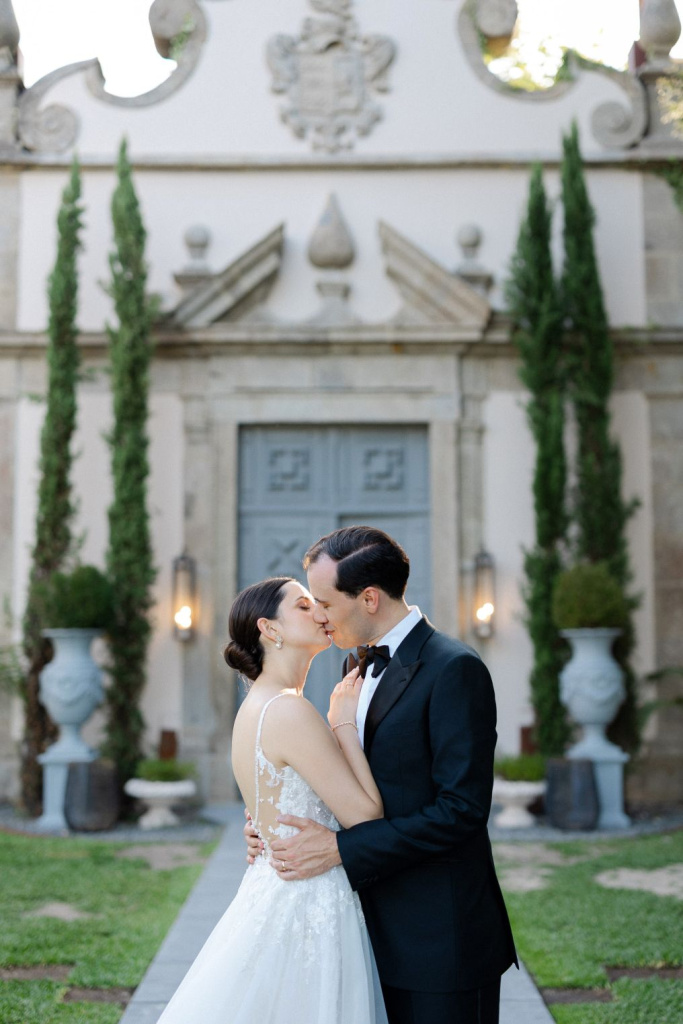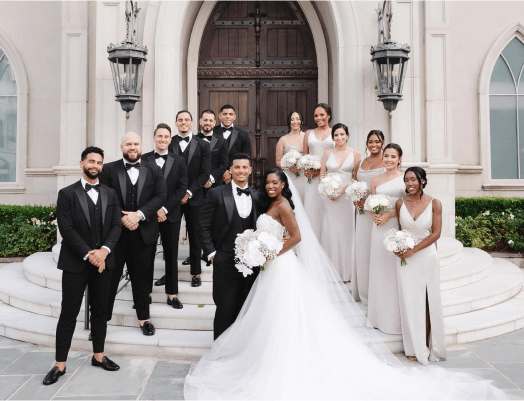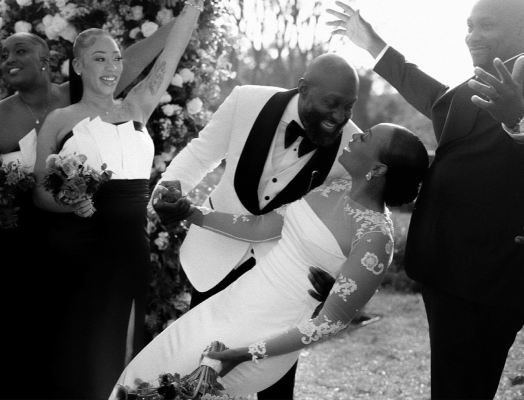How to Reduce Wedding Planning Stress: 10 Practical Steps
- Author: Natali Grace Levine
- Reading time: 8 min 47 sec
- Publication date: 08/22/2025
- Updated: 09/02/2025
- Kick Off with a Shared Vision: Your Couple’s Planning Compass
- Build a Practical Budget that Actually Works for You
- Assemble Your Dream Team
- Create a Practical Timeline: The Day-by-Day that Actually Works
- Delegate with Intention: What to DIY and What to Outsource
- Design a Guest Experience that Feels Effortless
- Build Stress-Relief Rituals for You Both
- Leverage Technology
- Contingencies, Safety Nets, and Comfort Plans You’ll Actually Use
- Celebrate Your Progress and Keep Your Connection Alive
If you’re planning a wedding right now, you’ve probably felt the tug between excitement and overwhelm. You and your partner deserve a day that feels like you, not a puzzle you’re constantly trying to solve. Knowing how to deal with wedding planning stress is key to making sure the experience remains enjoyable, not anxiety-inducing. This guide is your practical, heartbeat-fast approach to planning with less stress and more joy. Each section chucks you right into clear actions, quick wins, and tiny rituals you can weave into your routine together.


Find Your Perfect Wedding Vendors
Kick Off with a Shared Vision: Your Couple’s Planning Compass
Right at the start, you two set a compass for every choice you’ll make. Begin with a 60-minute vision date in a cozy spot, phones off, where you talk openly about the vibe you want for the day.
Define your mood—whether that’s romantic, casual, chic, or whimsical—decide how long you want the ceremony to feel, and pick one non-negotiable, whether it’s the food, the venue, or the music. Create a one-page planning compass that boils down to three must-haves, two nice-to-haves, and a color palette you both love, plus a signature detail you’ll repeat, such as a motif or a small decoration. This compass isn’t about locking in every detail; it’s about giving you a north star so decisions stop dragging on and you feel confident in each step.
To seal the moment, end each planning session with a two-minute appreciation for one another and lock in one decisive next step that you both feel good about.


Build a Practical Budget that Actually Works for You
Budgeting should never feel like a burden. With the right approach, it can be a simple, clear guide for your wedding planning. You don’t have to sacrifice your vision for the sake of savings, but you do need to be mindful of where your money goes. Understanding how to handle wedding planning stress starts with having control over your finances, which reduces unnecessary anxiety.
- Identify Major Categories: Start by listing all of the main categories: venue, catering, attire, photography, entertainment, décor, invitations, transportation, the wedding party, and miscellaneous. This gives you an overview of your spending.
- Allocate Percentages: Distribute your budget roughly in percentages. For example, about 40% could go to the venue, 20% for food, 10% for photography, and 10% for attire. Adjust these based on what matters most to you.
- Include a Contingency: Always add 10-15% as a contingency fund to cover unexpected costs.
- Create a Simple Tracking System: Use a basic Google Sheet or budgeting app to track every expense—how much you’ve spent, how much is due, and when.
Tip: Revisit the budget every few weeks to stay aligned. A budget sheet doesn’t just track your spending—it’s a powerful tool for reducing anxiety by providing clarity and control.
Building a budget early on ensures that you know exactly where your money is going, making adjustments much easier. It’s not about cutting costs—it’s about aligning your budget with your priorities as a couple, leaving room for flexibility without guilt.


Assemble Your Dream Team
Building a team of trusted wedding vendors and setting up a smooth communication flow is crucial to reducing stress and ensuring a seamless wedding day. Your vendors are the professionals who will help bring your vision to life, and their expertise is essential. However, effective communication with them is just as important as their skills. Establishing clear expectations from the beginning and maintaining organized, consistent communication will help keep everything running smoothly.
Start with the Must-Haves
When you begin assembling your vendor team, focus on the essential services you can't do without. These are typically the vendors that will be involved in the most important elements of your day—those who help set the tone and create lasting memories.
- Venue: Your venue is the foundation of your wedding, so it’s crucial to book this early in the process. The venue will often determine the style, size, and even the theme of your wedding, so it’s essential to make sure it fits your vision.
- Photographer/Videographer: The photographer and videographer capture memories that will last a lifetime, so it’s essential to hire a professional who aligns with your style. Browse portfolios, ask for recommendations, and don’t settle for the first one you find.
- Catering: Food and drink are key components of your wedding day. Whether you're opting for a plated dinner or a buffet, finding a catering team that provides excellent food and service is non-negotiable.
- Entertainment: Whether it's a live band, a DJ, or another form of entertainment, this vendor will set the tone for your celebration. Take time to find someone who matches the vibe you're going for and who knows how to keep the energy high throughout the evening.
Narrow Down Your Options
Once you’ve identified the essential vendors, it’s time to start narrowing your options. A good rule of thumb is to limit yourself to a manageable number of choices per category—three to five options. This ensures you’re not overwhelmed by too many choices and can focus on the best matches.
- Read Reviews: Online reviews and word-of-mouth recommendations can be incredibly helpful in finding reliable vendors. Make sure to look for feedback from couples who had a similar wedding style or size to yours.
- Request Quotes and Availability: Once you’ve shortlisted potential vendors, reach out to them for quotes and availability. This will help you get a better sense of pricing and whether they fit your budget.
- Ask for Client References: Don’t hesitate to ask for recent references from previous clients. This will give you insights into the vendor’s reliability, professionalism, and how they handle the pressure of wedding days.
Set Up Clear Communication Systems
Effective communication is the backbone of a stress-free wedding planning process. To ensure nothing falls through the cracks, establish clear communication systems from the very beginning.
- Create a Shared Planning Space: Use tools like Google Sheets, Trello, or even a dedicated email thread to keep everything organized. This will ensure you can track conversations, agreements, and updates in one easily accessible place.
- Define Roles and Responsibilities: Assign specific communication tasks to each of you, such as who will handle vendor emails, who will manage contracts, and who will keep track of payments. This way, you’re not stepping on each other’s toes and nothing gets missed.
- Set Communication Expectations: From the outset, define your preferred method of communication with each vendor. Agree on response times (e.g., within 48 hours) and outline how often you’d like to check in with them leading up to the wedding.
Tip: Consider creating a vendor checklist to keep track of contract deadlines, deposits, and any other important dates.

Create a Practical Timeline: The Day-by-Day that Actually Works
A realistic timeline acts like a calm breath in the middle of planning chaos. Start with a high-level 12 to 18 month plan that maps booking dates, dress fittings, save-the-dates, and invites, then develop a detailed 4 to 6 week lead-up with exact times for each event—vendor arrivals, setup, hair and makeup, transportation, and cue points for important moments. Build in buffer times between key moments to account for weather, delays, or traffic.
Here’s a simple timeline you can adapt:
- 12 or more months in advance, you’ve booked the venue and the photographer and sent save-the-dates
- 9 to 10 months in advance you tackle dress or suit shopping, consider second outfits, confirm the officiant, and sketch décor concepts
- 6 to 8 months brings invitations to draft, taste tests, and finalize entertainment; three months out, handle RSVPs, start the seating chart, and confirm vendor details
- 1 month before, lock in the final headcount, run of show, and weather contingency; the week of, do final rehearsals, make packing lists, and designate an on-the-day point person
Flexibility is essential, so include “rain plans” and “pause days” to recharge. Also keep a personal “temporal budget”—a cap on planning hours per week so you don’t burn out. If a week turns heavy, shift to easier tasks, and give yourselves permission to pause with a reminder of the big picture: you’re building a celebration of your partnership, not just ticking boxes.
Delegate with Intention: What to DIY and What to Outsource
You don’t have to do everything yourself, and you’ll likely be happier if you don’t. Decide what to DIY that still feels meaningful and worthwhile, such as welcome signs, simple décor, personalized seating cards, or handwritten thank-you notes, and what to outsource to save time and reduce stress—especially services that require professional expertise like photography, videography, catering, or day-of coordination. This is a key strategy for how to make wedding planning less stressful.
Create a clear “tasks by owner” plan that assigns responsibilities, deadlines, and exact deliverables. If budget is a concern, consider whether a few DIY projects can be traded for professional help that saves you substantial time. A weekend planner or day-of coordinator can be a lifesaver for managing logistics on the big day, so you can stay present with your loved ones.
The aim is to avoid burnout by balancing personal touches with the confidence that crucial pieces are in capable hands. If you’re unsure about coordinating multiple vendors, investing in a planner or coordinator is often a worthy choice; and give yourself permission to let go of intricate DIY crafts that aren’t fueling your joy. This approach will significantly help how to make wedding planning less stressful.


Design a Guest Experience that Feels Effortless
A guest-centered approach makes everything flow more smoothly. Start by mapping the guest journey—from arrival to goodbye—so you can anticipate needs and reduce confusion. Consider comfort elements like hydration stations, shade or heating options, clear signage, and accessibility, and craft a simple seating plan that minimizes awkward conversations and makes it easier for guests to mingle.
On the day, ensure a smooth flow: a welcoming area that feels accessible, a catering plan that keeps guests fed without long waits, and clean cues for transitions like entrances, the first dance, and speeches. For day-of ease, provide guests with a quick guide (ideally mobile-friendly) that explains where things are and what to do next. If kids are invited, a small, clearly marked kids’ corner can help, and having weather-appropriate extras—blankets for chilly evenings or fans for heat—keeps comfort at the front of mind.


Build Stress-Relief Rituals for You Both
Healthy rituals ensure that both of you stay grounded and connected throughout the planning process.
- Weekly Check-ins: Share your wins and woes. It’s a chance to celebrate the small victories and talk about anything that’s bothering you.
- Daily Five-Minute Reset: Try a short breathing or stretch routine together. Even a few minutes can help release tension.
- Pre-Wedding Ritual: Write a short thank-you letter to each other for your future selves to read on the wedding day.
Tip: Set boundaries around planning time—designate “phone-free” periods when you’re together. This keeps the planning from taking over every moment.


Leverage Technology
Technology isn’t the enemy; it’s a powerful ally if you use it with intention. Keep a shared cloud folder for contracts, timelines, and inspiration boards, and maintain spreadsheets for shopping lists, guest lists, RSVP tracking, and seating charts.
Wedding planning apps can help with task reminders, budget tracking, and vendor management, but the real wins come from templates you can customize and reuse. Create a budget template that tracks deposits, due dates, and paid versus unpaid statuses, a vendor contact sheet that includes backup numbers and on-the-day roles, and a seating chart and RSVP tracker you can refer to at a glance.
For hacks, curate a single inspiration board—using Pinterest or a shared mood board—so decisions stay aligned, and set calendar invites for pivotal planning milestones like venue tours, dress fittings, and major payments.


Contingencies, Safety Nets, and Comfort Plans You’ll Actually Use
Every plan needs a safety net. Build a practical contingency that you’ll actually rely on: a weather backup plan, alternate vendors if a key player falls through, and a straightforward on-the-day communication protocol so everyone—ahem, including you—knows who to contact when something shifts.
Create a simple emergency kit for the day that includes basics like batteries, tape, scissors, sewing kits, safety pins, and spare chargers, plus a written run-of-show that your point person can carry. Prepare a comfort plan for guests too: accessible restrooms, clearly marked signage, a quiet space for those who need a moment away, and light, easy refreshments that soothe nerves.



Celebrate Your Progress and Keep Your Connection Alive


As you close each planning chapter, take time to celebrate the progress you’ve made and the partnership you’re strengthening. Schedule a couple’s date night every few weeks to revisit your vision, review the latest decisions, and simply enjoy being together. Use a shared notes space to capture triumphant moments and learning experiences, so you can look back with gratitude and confidence when the big day arrives.
Finally, remember that the most important element of your wedding day is the bond you’re creating and celebrating—everything else is a frame for that moment. By choosing to approach planning with intention, humor, and care for one another, you’ll find that the process becomes less about fixing problems and more about building memories you’ll carry long after you say “I do.”






















